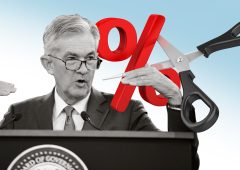US Inflation Data Shows Annual Increase, Core Prices Cool
15.01.2025 16:08 1 min. read Alexander Zdravkov
US inflation data revealed an annual increase of 2.9% in December, up from 2.7% in November, according to the Bureau of Labor Statistics (BLS).
The figure aligned with market expectations, while monthly inflation rose by 0.4%, following a 0.3% uptick in the prior month. Core inflation, which excludes food and energy, grew by 3.2% year-on-year, slightly below both November’s 3.3% and analysts’ forecasts. On a monthly basis, core inflation increased by 0.2%.
The release of these figures had an immediate impact on financial markets. The US Dollar Index (DXY) slipped below the 109.00 mark, hitting new multi-day lows in response to the data.
Earlier projections had anticipated December’s CPI to rise by 2.9% annually and core inflation to hold steady at 3.3%. Analysts suggested the report might reinforce the Federal Reserve’s current stance on monetary policy, with no immediate rate adjustments expected at the January meeting.
The Federal Reserve’s December meeting minutes highlighted concerns over persistent inflationary pressures. Officials noted potential challenges posed by shifts in trade and immigration policies, which could complicate efforts to control inflation and shape the broader economic outlook. Analysts at TD Securities had predicted a slight decline in core inflation due to falling goods prices, potentially offset by rising housing costs. The December CPI figures seem to affirm a steady but cautious inflationary trend heading into the new year.
-
1
Billionaire Warns of Slowing U.S. Growth, Sees 45% Chance of Downturn
20.05.2025 14:00 1 min. read -
2
China Quietly Advances Yuan as Dollar Alternatives Gain Ground
20.05.2025 17:00 2 min. read -
3
Economic Instability and Political Shift Fueling Bitcoin’s Rise – Galaxy Digital CEO
23.05.2025 12:00 2 min. read -
4
Trump Renews Attack on Fed Chair, Calls for Immediate Rate Cuts
18.05.2025 8:00 1 min. read -
5
Japan’s Inflation Hits 3.5% as Food Prices Soar and Tariff Risks Loom
23.05.2025 21:00 1 min. read
Tariffs Threaten to Stall U.S. Growth in 2025, Recovery Not Expected Until 2026
The U.S. economy may be closer to a downturn than many realize, according to Jay Bryson, chief economist at Wells Fargo.
Dollar Faces Deep Decline as Fed Cuts Pressure Currency, Warns Morgan Stanley
Morgan Stanley has issued a cautionary outlook on the U.S. dollar, predicting a major decline over the coming year as Federal Reserve rate cuts take hold.
Trillions in Debt Payments Could Break U.S. Economy, Ray Dalio Predicts
Legendary investor Ray Dalio has issued a stark warning about the trajectory of U.S. government finances, suggesting the country is drifting toward a series of severe economic shocks unless its debt spiral is urgently addressed.
Wall Street Veteran Warns Tariffs Could Disrupt AI-Driven Market Rally
Steve Eisman, the famed investor known for forecasting the 2008 housing collapse, is sounding the alarm—not on overvalued tech stocks or interest rates, but on the escalating risk of global trade disputes.
-
1
Billionaire Warns of Slowing U.S. Growth, Sees 45% Chance of Downturn
20.05.2025 14:00 1 min. read -
2
China Quietly Advances Yuan as Dollar Alternatives Gain Ground
20.05.2025 17:00 2 min. read -
3
Economic Instability and Political Shift Fueling Bitcoin’s Rise – Galaxy Digital CEO
23.05.2025 12:00 2 min. read -
4
Trump Renews Attack on Fed Chair, Calls for Immediate Rate Cuts
18.05.2025 8:00 1 min. read -
5
Japan’s Inflation Hits 3.5% as Food Prices Soar and Tariff Risks Loom
23.05.2025 21:00 1 min. read


